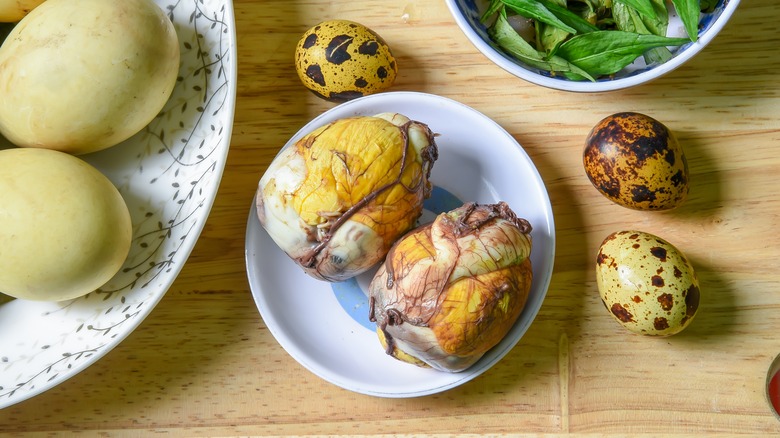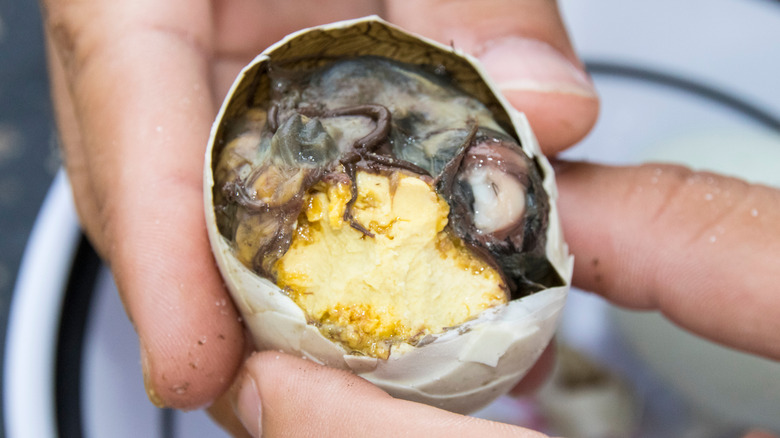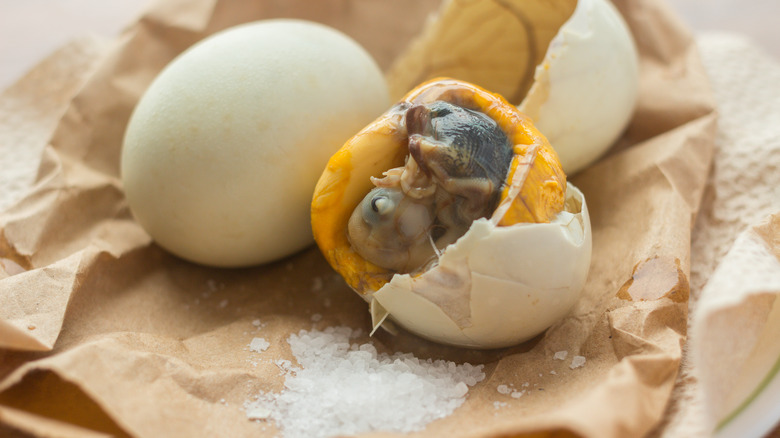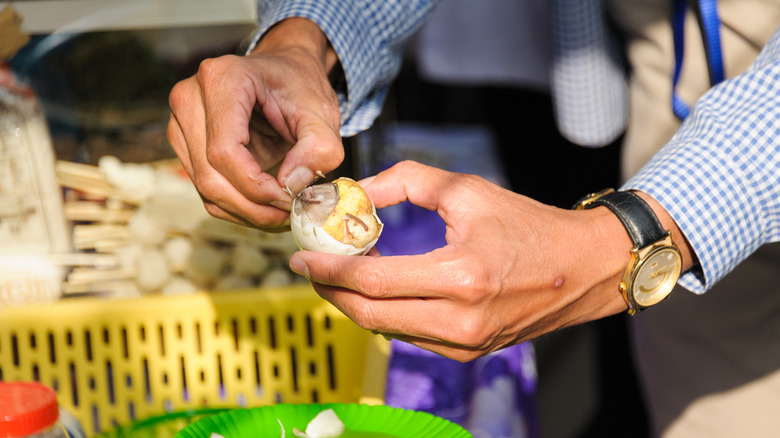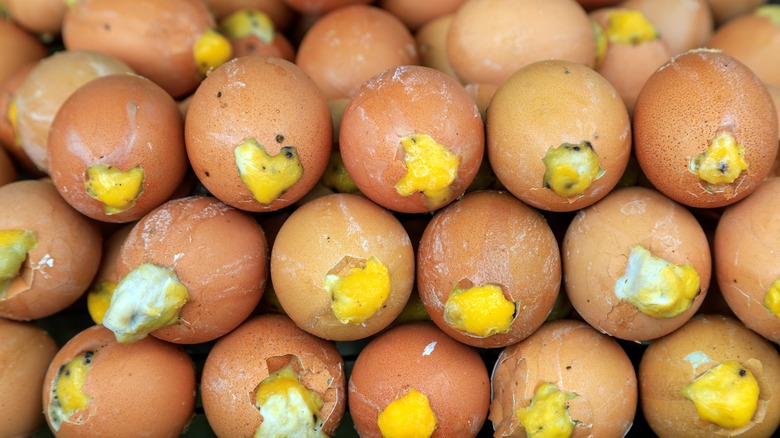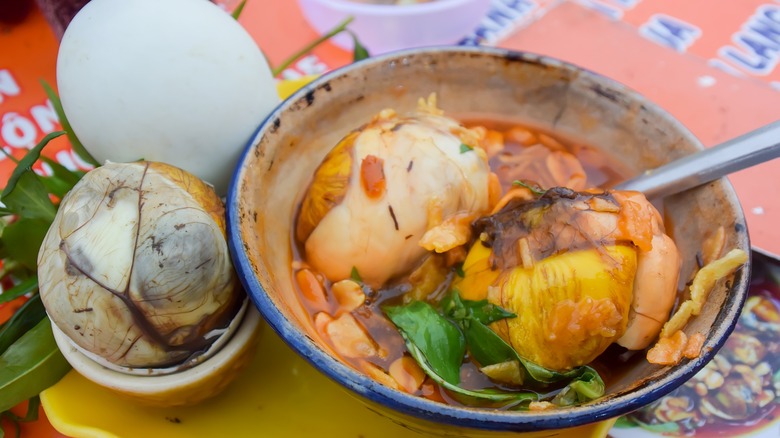What Is Balut And How Did It Become A Popular Street Food?
Poached, boiled, scrambled, and fried are universally enjoyed methods of devouring eggs, but each culture has its own unique way of preparing and eating them. In China, eggs are marinated in a paste of clay, wood ash, salt, and quicklime or slate lime to create century eggs; a thick layer of sausage encases a hard-boiled egg in the United Kingdom's deep-fried Scotch eggs; and in India, eggs are often enjoyed hard-boiled and slowly simmered in spicy, tangy curries. However, in the Philippines, balut remains one of the most preferred ways of eating an egg — it's a street food delicacy that is as popular in the country as hot dogs doused in ketchup and mustard are in the United States.
Duck farming is a major industry in the Philippines, and balut is its primary product. Named after the Tagalog phrase balut sa puti, meaning "wrapped in white," balut's name pays homage to its appearance. At its core, balut is a fertilized duck egg that has been incubated for roughly 18 days. The two-and-a-half-week incubation period allows the duck embryo to develop, meaning there is a partially formed bird encased inside a cocoon of white layer within the egg!
Where did balut come from?
While balut is very much a Filipino delicacy — and similar fertilized duck eggs do exist in the form of hot vit lon and phog tea khon in Vietnam and Cambodia — its roots lie in China. Mentions of eggs hatched and incubated for 10 to 12 days exist in Chinese texts dating back to 1830, but these eggs were far from being affordable street food: They were a delicacy enjoyed by the affluent at ritzy parties. Some historians have also found that the Chinese used to fertilize their duck eggs in a preparation known as maodan — meaning hairy or feathered eggs, thanks to the tufts of hair on the developed embryos — to prolong the shelf lives of eggs at a time when refrigeration had yet to be invented. Balut is even thought to be a distant cousin of Chinese century eggs and salted eggs, further reinforcing its ancestral ties.
Balut's popularity in the Philippines began sometime after Chinese traders settled on the banks of Laguna de Bay — a region that was home to Mallard ducks, which presented a ripe opportunity for the production of duck eggs and, subsequently, balut. Duck farming grew so much in the area that one settlement was later named the Municipality of Pateros, or duck raisers. Once known as the balut capital of the country and distinguished for its high-quality fertilized eggs, Pateros was home to an estimated 400,000 ducks in its heyday!
How is balut prepared?
To prepare balut, the most important step is choosing the right duck eggs: They should have thick shells without any cracks or fissures, as these are more likely to survive incubation. The chosen duck eggs are then sun-dried to eliminate moisture, after which they should be ready for incubation. The eggs are placed in trays or bags and incubated in tall bamboo barrels known as balutans, often with a mixture of rice husk and mud sandwiched between them to aid the process. Alternatively, the eggs can also be fertilized in mechanical incubators.
The eggs are usually kept in the balutans or incubators for 18 days, and are carefully monitored throughout. Producers use a method known as candling, which enables them to see the formation of the embryo inside the egg and gauge whether it is ready for eating. Once deemed suitably incubated, the duck eggs are briefly air-dried, boiled in a solution of salt and water for up to 30 minutes, and then sold to balut-loving customers, preferably hot off the pot.
Balut's texture depends on its incubation period
There's a reason why balut is incubated for 18 days — it is the sweet spot that gives the fertilized duck eggs just the right texture! Balut contains four elements: the yolk, the white (also known as albumen), the liquid (also known as the soup), and the embryo. The texture of these elements can vary depending on the incubation period.
Eggs incubated for a shorter period — say around 16 days — will have embryos that are not fully developed, resulting in a softer texture. The longer an egg is incubated, the more its embryo develops, featuring more discernible beaks, feathers, and bones, until it eventually hatches at the 28-day mark. These eggs have a crunchier texture and rubbery egg whites, known as bato or stone. Conversely, extremely young eggs incubated for 14 to 16 days are called mamatong, and are so tender that the embryo floats inside the egg.
This is why an 18-day-old egg, or balut sa puti as it is known, is considered ideal — the embryo is only partially developed and has a creamy, mousse-like texture. That said, balut's texture is quite complex. Due to the various elements inside and their individual textures, you can experience crunchy, meaty, soupy, and slimy textures all in one spoonful.
Eating balut and its flavors
Balut's flavor profile is far from single-note. Contestants in balut eating contests (yes, they are very much a thing!) have described it as a "chicken egg on steroids" that "really does taste just like a boiled egg" (via NBC News). The overall taste of balut is also a culmination of the flavors of its individual elements. While the liquid or soup tastes like watery chicken broth, the embryo has notes of vinegar, and the yolk is reminiscent of custard, but with a distinct piscine quality.
To savor each element and its unique flavor and texture, eating balut requires some skill. Instead of cracking the entire egg open, balut is typically eaten by making a small opening at the top of the egg. A pinch of salt is sprinkled inside, and the warm, savory soup is slurped down. Only after every last drop of the soup is consumed is the rest of the shell peeled off and the yolk and embryo dug into (the egg white is often discarded due to its rubbery texture). Some may bite into the egg as it is, while others may separate the yolk and embryo, douse them in vinegar, herbs, or soy sauce, and eat them with a spoon. Regardless of how one prefers their balut, the fertilized duck egg is always eaten hot.
Balut is a beloved Filipino delicacy for many reasons
Balut holds an important place in Filipino culture, especially as a late-night street food, and this significance extends beyond its taste and texture. Balut is an affordable and nutritious source of sustenance that appears on the streets of the Philippines after dusk. While some say that the beaks and bones of a fertilized duck embryo are less noticeable under the cover of darkness, its popularity as a late-night snack has more to do with its ability to energize and fill the stomachs of those working (or partying) at night.
Balut is packed with protein, and is also high in calcium and iron. Perhaps its most significant benefit in Filipino culture, however, is balut's alleged aphrodisiac properties — some people consume balut as a sexual stimulant. Moreover, the fertilized duck eggs are popular snacks to enjoy with alcoholic drinks, and are rumored to help with severe hangovers the morning after, further explaining why balut is a particularly favored delicacy after sunset!

